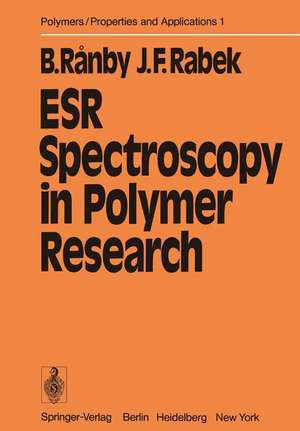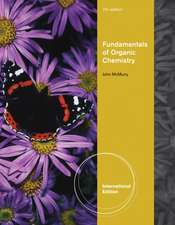ESR Spectroscopy in Polymer Research: Polymers - Properties and Applications, cartea 1
Autor Bengt Ranby, Jan F. Rabeken Limba Engleză Paperback – 7 dec 2011
Preț: 649.71 lei
Preț vechi: 764.37 lei
-15% Nou
Puncte Express: 975
Preț estimativ în valută:
124.32€ • 129.81$ • 102.66£
124.32€ • 129.81$ • 102.66£
Carte tipărită la comandă
Livrare economică 15-29 aprilie
Preluare comenzi: 021 569.72.76
Specificații
ISBN-13: 9783642666025
ISBN-10: 3642666027
Pagini: 428
Ilustrații: XIV, 410 p.
Dimensiuni: 170 x 244 x 22 mm
Greutate: 0.68 kg
Ediția:Softcover reprint of the original 1st ed. 1977
Editura: Springer Berlin, Heidelberg
Colecția Springer
Seria Polymers - Properties and Applications
Locul publicării:Berlin, Heidelberg, Germany
ISBN-10: 3642666027
Pagini: 428
Ilustrații: XIV, 410 p.
Dimensiuni: 170 x 244 x 22 mm
Greutate: 0.68 kg
Ediția:Softcover reprint of the original 1st ed. 1977
Editura: Springer Berlin, Heidelberg
Colecția Springer
Seria Polymers - Properties and Applications
Locul publicării:Berlin, Heidelberg, Germany
Public țintă
ResearchCuprins
1. Generation of Free Radicals.- 1.1. Free Radicals, Biradicals, and Radical Ions.- 1.2. Basic Properties of Free Radicals.- 1.3. Free Radical Reactions.- 1.4. Interaction of Electromagnetic Radiation with Matter.- 1.5. Interaction of Charged Particles with Matter.- 1.6. Physical Sources of Free Radicals.- 1.7. Chemical Sources for the Production of Free Radicals.- 2. Principles of ESR Spectroscopy.- 2.1. Introduction.- 2.2. Interaction Between the Electron Spin and Internal Magnetic Field.- 2.3. Spin Relaxation.- 2.4. The Shape of ESR Resonance Lines.- 2.5. g-Value.- 2.6. Interaction Between the Electron and the Nuclear Spins.- 3. Experimental Instrumentation of Electron Spin Resonance.- 3.1. ESR Spectrometers.- 3.2. Field Sweep Calibration.- 3.3. Measurements of Spin Concentration.- 3.4. Measurements of ESR Spectra at Different Temperatures.- 3.5. Computer Application into ESR Spectroscopy.- 3.6. Preparation of Samples for ESR Experiments.- 3.7. Special Techniques for ESR Spectroscopy.- 4. ESR Study of Polymerization Processes.- 4.1. Homogeneous Chain-growth Polymerization.- 4.2. Ionizing Polymerization.- 4.3. Photopolymerization.- 4.4. Thermal Polymerization.- 4.5. Polymerization Initiated by Mechano-radicals.- 4.6. Polymerization Initiated by Various Free Radical Initiation Systems.- 4.7. Anionic Polymerization.- 4.8. Cationic Polymerization.- 4.9. Heterogenous Chain-Growth Polymerization.- 5. ESR Study of Degradation Processes in Polymers.- 5.1. Radiation and Photo-Degradation of Polymers.- 5.2. Free Radicals Formed in Glow Discharge of Polymers.- 5.3. Anionic Degradation of Vinylaromatic Polymers.- 5.4. Reaction of Polymers with Hydroxy Radicals.- 6. ESR Study of Polymers in Reactive Gases.- 6.1. Molecular Oxygen.- 6.2. Singlet Oxygen.- 6.3. Atomic Oxygen.- 6.4. Atomic Hydrogen.- 6.5. Atomic Nitrogen.- 6.6. Noble Gases.- 6.7. Other Gases.- 7. ESR Studies of the Oxidation of Polymers.- 7.1. Radiation-Induced Oxidation of Polymers.- 7.2. Polyethylene.- 7.3. Polypropylene.- 7.4. Poly(tetrafluoroethylene).- 7.5. ESR Studies of Antioxidants.- 8. ESR Studies of Molecular Fracture in Polymers.- 8.1. Introduction.- 8.2. Generation of Submicrocracks.- 8.3. Generation of Free Radicals in Mechanically Deformed Polyethylene.- 8.4. ESR Study of Free Radicals Formed During Fracture in Rubber.- 8.5. ESR Study of Fatigue Processes in Polymers.- 8.6. ESR Study of Free Radicals Formed During Grinding and Machining of Polymers.- 8.7. Anomalous Behavior of Free Radicals Obtained by Sawing Technique.- 8.8. Mechanical Degradation of Polymers in Frozen Solution Matrix.- 9. ESR Studies of Graft Copolymerization.- 9.1. Graft Copolymerization of Polyethylene.- 9.2. Cellulose Graft Copolymers.- 9.3. Miscellaneous Problems.- 10. ESR Studies of Crosslinking.- 10.1. ESR Study of Enhanced Crosslinking of Polymers.- 10.2. ESR Study of Free Radicals Observed During the Curing of Unsaturated Polyester Resins.- 10.3. ESR Study of the Vulcanization of Rubber.- 10.4. ESR Spectra of Light-Irradiated Poly(vinyl cinnamate).- 11. Application of Stable Free Radicals in Polymer Research.- 11.1. Nitroxide Radicals.- 11.2. Spin-Probe Technique.- 11.3. Spin-Trapping Technique.- 11.4. Spin-Labeling Technique.- 12. ESR Spectroscopy of Stable Polymer Radicals and their Low Molecular Analogues.- 12.1. Poly(triphenylmethyl) Radicals.- 12.2. Poly(?,??-diphenyl-p-xylene) Radicals.- 12.3. Polyphenoxy Radicals.- 12.4. Poly(triphenylhydrazyl) Radicals.- 12.5. Polymers Containing Stable Free Radicals of the Nitroxide Type.- 12.6. Poly(pyridinyl) Radicals.- 12.7. Poly(verdazyl)Radicals.- 12.8. Polymers Containing Stable Free Radicals of the Tetrazine Type.- 12.9. Polyradical Anions.- 12.10. ESR Study of Donor-Acceptor Polymer Complexes.- 12.11. Organic Polymeric Semiconductors.- 12.12. Free Radicals Formed by Pyrolysis of Polymers.- 12.13. Free Radicals in Carbon Black.- 13. ESR Study of Ion-Exchange Resins.- References.





















